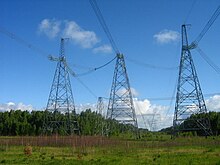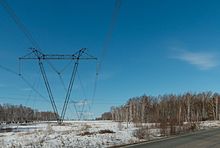Three-phase line Ekibastus – Kökschetau

The three-phase line Ekibastus - Kökschetau - Qostanai ( Russian Экибастуз – Кокчетав – Кустанай ) is an overhead line for electrical energy transmission with a nominal voltage of 1150 kV, which is unique in the world and is operated by the Kazakh energy supplier KEGOC . The power is given as 5500 MVA. It is part of the overhead line from Itatsk, Siberia to Chelyabinsk (Челябинск) in the Urals . The line uses bundled conductors with eight individual conductors each.
Construction began in 1980, and it was partly put into operation in 1985 and 1988. This power line runs from the Ekibastus power plant over approx. 700 km to Qostanai in Kazakhstan and is mounted on triangular high-voltage pylons 60 m high. By expanding to the east, the cheaper night-time electricity from Siberia can be used due to the time difference in the Urals.
Coordinates of the substations
Individual evidence
- ↑ Kegoc transmission networks ( page no longer available , search in web archives )
- ↑ Operation and environmental impact of the three-phase line Ekibastus – Ural ( Memento of August 12, 2011 in the Internet Archive ) (PDF, Russian, with graphics and photos)
- ↑ http://lib-ekb.kz/upload/iblock/a30/a30eb124d6dd420e6414ed86740747e1.pdf
Web links
- ( Page no longer available , search in web archives: history of energy supply )
